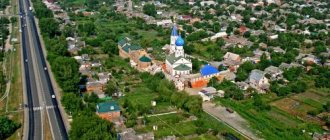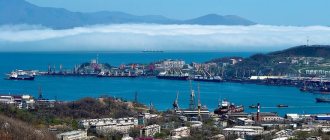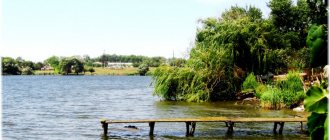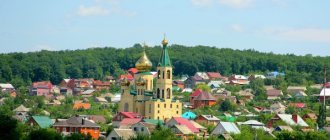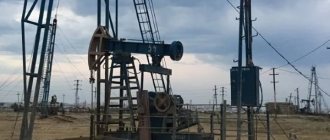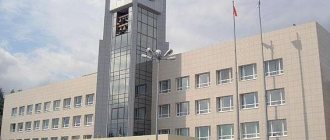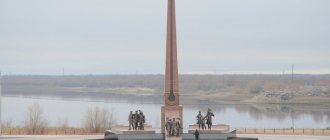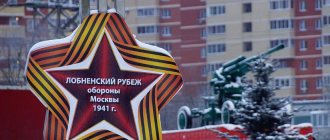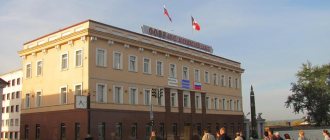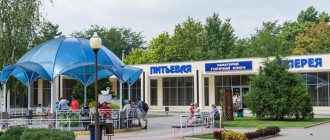The small town of Krymsk, Krasnodar Territory, is located at the foot of the main Caucasus ridge on the banks of the Adagum River, a tributary of the Kuban, at a distance of 100 kilometers from Krasnodar. It is the center of the Crimean region. The city has a railway station of the Caucasian Railway, developed infrastructure and a military airfield in close proximity.
Climate, population and coat of arms
The climate in the city is moderate continental. Winters are short and warm with average temperatures of 10 degrees. In January there are severe frosts of -25 degrees with piercing winds, which brings a lot of problems. Spring comes early; at the beginning of March there is no more snow. And in April there are frosts during apricot flowering. Summer in Krymsk begins in May. The temperature in July rises to 35 degrees, and sometimes up to 40.
On hot days, local residents go to the sea or go to the mountains to waterfalls. Summer lasts until early October.
The number of residents in Krymsk in 2021 was more than 57,000 people. There was a slight decline compared to the previous year. By ethnicity, the majority of residents of Russian nationality, together with the Kuban Cossacks, make up 80%. The city is multinational; Armenians, Greeks, Assyrians, Uzbeks, Ukrainians, Turks, Tatars and others live in it. 10% of the population of Krymsk are immigrants for permanent residence from other regions of Russia or nearby villages. Women make up 55%, children - 20%, pensioners - 23%.
There is a coat of arms of Krymsk, approved in 2007 - a silver St. Andrew's cross in an azure field, filled with scarlet at the top and a narrow gold belt with loopholes in the middle.
The coat of arms, in the language of allegories and symbols, reflects the historical, economic and geographical features of the urban settlement of Krymsk.
Postal code - 353351. Telephone code - 86131.
Ethnicon: Crimeans, Crimean, Crimean woman.
Eyewitnesses:
-On the street, in the dark, there were people screaming for help, screaming loudly. The corpses of animals, furniture, cars floated past. -We called for help, but no one heard us. - a neighbor woke us up shouting “Valya, we’re drowning!” Save the children! -A neighbor’s son serves in a military unit, he was called at 11 pm without saying anything. -In the morning the police came and told us not to tell anyone anything. -Near the place where the fence stood, a cherry tree grew, and the girl, frantically clinging to it, cried and screamed, asking for help. Then the scream disappeared into the night.
I talked with rescuers.. On the morning of July 8, there were officially 110 corpses, during that hour there were 10 more, but this is just the beginning, according to them. These are the ones that were pulled out from under the rubble, which had JUST begun to be dismantled. Many are expected to die. There are a lot of missing children. Officially, 4 children died.
I walked along all the streets, often knee-deep in water and mud and nowhere!! No one from the administration was visible anywhere. The police were on the outskirts of the city. The Ministry of Emergency Situations stood shyly at the beginning of the street. To the question, why are you standing? the answer was devastating - “We don’t have gasoline.” People cried, saying that they were simply drowned like kittens. No one from the local administration came (and these are the words of residents of more than one building). Distribution of dry rations and water? -You need? Come and take it. And this is 3-5 km from home... It’s sunny outside, before lunch it rained periodically, not significant. She brought a trunk full of water and immediately distributed it. I met volunteers from Pyatigorsk - the guys were handing out water, bread, and blankets. Thank them very much.
Cellular communications in the city yesterday worked very strangely - there was a network, full antennas, but people could not make calls. Strange, isn't it?
History of Krymsk
The history of Krymsk begins in 1858, when the Crimean Fortress was built on the site of the village by retired soldiers. Five years later, in 1863, a village was formed in which 140 former military men who worked at an oil well lived. In 1886, the Church of St. Michael of the Archangel was built, and 2 years later a railway with a junction station was opened, through which a train ran on the route Yekaterinodar (Krasnodar) - Novorossiysk.
By the beginning of the twentieth century, the town had 150 retail shops, a Greek school, 3 cinemas, a recreation garden, and a coffee shop. 20,000 people lived in the village of Krymskaya. By 1914, factories were operating in the settlement: a tannery, a brick factory, a canning factory, a brewery and a creamery. In 1920, Soviet power was established in the village. During these years, the economy developed rapidly. By the end of 1932, a canning factory was built, more than 40 collective farms were created, the first breeding station in the region, and a winery.
Tens of thousands of residents of the region and Krymsk fought with German troops during the Second World War, 18,000 died or went missing. In the post-war period, the city gradually established a peaceful life. The economy developed at a rapid pace - new factories were put into operation and existing ones were reconstructed, 3 schools and 2 kindergartens were built. And only in 1958 Krymsk officially became a city.
An unexpected flood that occurred on July 6-7, 2012 in the Krasnodar region led to the death of at least 150 people, mainly in the small town of Krymsk. The water level in the area rose to 7 meters, and entire villages were washed away. The situation was made worse by the fact that the flood occurred at night, when most people were sleeping in their homes. About thousands of houses were destroyed by the disaster. The head of the administration told the victims that 9 billion rubles had been allocated from the federal and regional budgets for the restoration of Krymsk.
I saw covered corpses of people on the streets.
The victims practically say with one voice that the governor deceived the president. There was a drain! And the discharge came from the Neberzhitsky reservoir. I went to make sure that the Varnavinskoye Reservoir was not to blame, and it turned out to be so. I talked with the caretaker and the service staff. The level there is the same and the drain is not noticed. I didn’t get to Neberzhitsky because... Citroen is not a jeep, and this time it didn’t work out. The road is washed out. I followed the path of the flowing water, making my way through the rubble from the stream to the river itself, walking in silt and sand above my knees (I was afraid that my sneakers would remain there). Everything indicates that the water came from this reservoir. Stop lying, gentlemen in power. People are not stupid. Nobody! Listen, NO ONE remembered the president or the governor with a kind word, but no one got involved in politics either. They asked for help, water, clothes and bread. This is what they need now. Higher up, in the area of the third school, I saw the first working pumps. Well, how working... the engines are roaring strainedly, and it’s very difficult to suck out the sludge. On other streets, people scoop up water and mud on their own. No electricity, gas, water. And no one knows when they will turn it on. She caught a bus driving down the street with the sign “Headquarters” on it, brazenly blocked his way, asked him to explain what exactly they were doing and why their so-called headquarters didn’t have basic things for people?? To which I received a drop dead important answer - We are working! -Who are we? Explain? There was no answer, the driver frantically rushed forward.
I tried to go to the administration - the water pumping equipment was very actively working there. just like in the savings bank, but cheerful police stopped me, saying, “Take the camera away.” Not allowed. To my question - why don’t you help people? Why are you saving the administrative buildings when people are knee-deep in mud and water?? The answer is, first of all, we clean out these buildings for work... They kicked us out, threatening to break the camera, adding, divorced you here, the curious...
People thanked me, but I was very ashamed... Ashamed that I couldn’t help them with anything other than water...
City districts
If you look at the map, which shows a detailed plan, you can see that the whole of Krymsk is divided into districts. Each of them has both advantages and disadvantages, as well as unofficial names:
- Railway Station and Selection Station (OSS);
- Rock;
- Microdistrict;
- Central Market;
- Military City;
- Pig market;
- Greenhouses;
- Secondary school No. 3;
- Secondary school No. 6;
- Secondary school No. 7.
Two districts - the Railway Station and the Experimental Selection Station - are located on both sides of the railway tracks and are densely populated. There is no crossing path, and residents have to go out of town to get home. The busy M4 highway passes through the area, and traffic flows around the clock. In addition to noise, accidents involving pedestrians often occur.
"The Rock" is the largest region of the city, which in the past was intended for migrants. Meskhitian Turks live here. The long Lunacharsky Street runs through the area.
There are only private one-story houses with garden plots; the infrastructure in the region is well developed.
Not far from the center, near the ring road, there is a cozy and quiet Microdistrict. It has all the necessary infrastructure, new supermarkets and multi-storey buildings are being built. Residents farm in the immediate vicinity.
The Central Market area occupies the main part of the city with administrative buildings, shopping malls, medical institutions, gardens, and schools. On the bank of the river, the Crimean “Rublyovka” is being built - the Teplitsy or Slobodka microdistrict. The only school-lyceum in Krymsk was opened here.
On the outskirts is the Pig Market area. In Soviet times, meat was traded here, which is why it got its name. Subsequently, the territory was expanded and they began to sell household goods and spare parts for cars. Nowadays it is the “DIN” car market, but the previous name has been preserved.
Families of military personnel working at the closed airfield live in the Military Town. All the necessary infrastructure is available here. A minibus runs to the city center.
Arina Sokolova
This is what Arina Sokolova wrote in her article https://kotenarina.livejournal.com/336013.html
Have you been to hell? I haven't before. So... Krymsk today is a branch of hell on earth. What's happening there is scary. I’ll say right away - I confirm 100% - THERE WAS A WATER DISCHARGE!!!! It's not rain.
In the morning I left Krasnodar for Krymsk, the road to Novoukrainskaya is quite clean. At the entrance to Krymsk there are huge queues of trucks. I asked the drivers why, they don’t know. Besides the fact that the traffic policeman is pulling out of the car. They stand like this for the second day.
When driving onto the bridge, there were torn out pieces of asphalt that were carried around like sheets of paper. There is partially no asphalt near the railings. Fuel oil is spilled on the road, the smell is clearly noticeable. Fences with brick pillars lie on the ground, sheets of iron are bent with superhuman strength. It can be seen that there was a wave of water, and this wave was huge. The level of incoming water can be seen in the houses. Many houses have no roofs and walls have collapsed. Inside is a mixture of mud and silt, 30-40 cm thick. I walked through about 26 houses, people themselves asked to go inside and see WHAT IS GOING ON THERE. Furniture, REFRIGERATORS - LIKE TOYS - SCORED IN CORNERS. Things and equipment were taken out into the gardens and orchards. Everything is covered in dirt. There were overturned cars everywhere, the stream was demolishing everything in its path. People cry.. You know.. this is that feeling of fear, hopelessness that you feel physically. Pain. A woman with two sons, 13 and 16 years old, stood for 5 hours on a pyramid of kitchen and coffee tables, watching the water rise, praying just to survive. In the house next door to hers, a grandmother and her daughter drowned. Many victims. The police came at me with a stupid question: what right do I have to take photographs here? Realizing that I couldn’t adequately explain anything to these guys and the situation was not developing in my favor, when they started grabbing the camera strap, I had to voice those whose support I had enlisted, whose support I was officially promised at the time I was in the city, include the fifth speed and retreat through mud and puddles.
Now what I heard personally from the residents of Krymsk. And I will subscribe to every word they say! This is not a situation for them to cheat. There was NO notification! At 10 pm the power suddenly went out. People thought it must have been an accident, without attaching any significance. Between 12:00 am and 01:00 am, a roar suddenly arose, those who were not sleeping jumped out into the street and fell into the water, because... the water was rising and the courtyards were already flooded. The water was rising until about 5 am, then it slowly began to decline.
Sights and culture
There are many interesting monuments in the city. On the official website and on Krymsk. ru. You can find information about the sights of Krymsk and photos with their descriptions. These include:
- Memorial "Hill of Heroes". The eleven-meter figure of a soldier - a hero of the Second World War is installed on a high pedestal. The monument was opened on the anniversary of the Victory over Nazi Germany in 1967.
- Kurgan Karagodeuashkh. Dating back to the 4th century BC. e., this is the burial place of the Meotian leader. The discovered relics and artifacts replenished the Hermitage collections.
- The remains of the Crimean fortress built in 1858.
- "Grandma tower." Monument to the first oil well in Russia, drilled in 1864.
- Museum of Local Lore. Introduces you to numerous documents and exhibits of the history of the region and the city. A separate room dedicated to the Second World War displays a panorama of military battles, a collection of weapons, and personal belongings of soldiers and generals.
- "Shugo Hill". Mud volcano in the Caucasus Mountains basin. The vast territory contains several dozen small volcanoes at different stages of formation. Some actively spew out warm healing mud. Currently, a recreation area has been created here where you can take mud baths. There are showers and dry closets. In summer you can relax in the cafe. Minibuses and buses run regularly to the volcano.
many other interesting places on the territory of the Crimean region
- State farm winemaking "Sauk-Dere", whose wine cellars store the largest collection of wines in the state.
- Centers of ethnography and history “Caucasian Legends” and “Circassian Village”.
- Source "Holy Handle". The picturesque place in the mountains is perfectly equipped for a summer holiday. Often city residents come with their families for barbecues.
- Tourist office opened in 2015. Here you can book excursions, hire a guide, and find out news about the life of the city and its inhabitants.
Ten kilometers from Krymsk there is the old Varnavinskoye reservoir. Residents of the city come here on vacation in the warm season to fish.
Economics and education
The Crimean region is an economically developed region. New enterprises and factories are constantly being put into operation. Among food industry facilities, the cannery is of primary importance in the city, the products of which are supplied to all regions of Russia. There is a flour mill and a Crimean winery. The most famous wineries in the area:
- "Lefkadia". Produces dry and sparkling wines.
- "Sauk-Dere". The agricultural company produces well-known varieties: Aligote, Chardonnay, Savignon, Pinot, Cabernet.
- "Chateau le Grand". A French-Russian enterprise produces dry natural wines.
Chemical production of polypropylene containers has been developed, glass container and iodine factories have been built and put into operation. Brick and concrete are produced in the region, and large clay deposits are developed.
However, agriculture is the leading sector in the economy of the Crimean region. The area of agricultural land is more than 90,000 hectares; grain crops, vegetables, fruits, legumes, and berries are grown. More than 2 thousand hectares are sown with rice. There are about 500 farms and agricultural enterprises in the region. Dairy and meat production has been developed, poultry farms and bee apiaries, mink farming have been built, and fish farms are being created.
The city has 13 kindergartens, 9 schools, the Crimean Industrial Construction College (CIST) and a technical college. Problems in the preschool education sector are reflected in the shortage of kindergartens.
Mothers wait in line for 3-5 years. The problem is gradually being resolved at the regional level.
